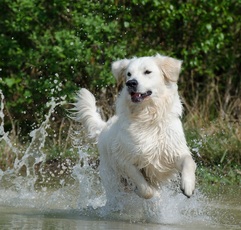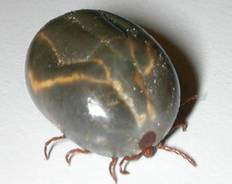Issue 22
Summer Brings Potential for Toxins
 The warm weather of summer brings a potential for harmful
algal blooms (HABs). HABs occur when cyanobacteria (also known as blue-green algae), which is commonly found
in lakes, streams, rivers, and ponds, grows quickly and produces toxins. This
commonly occurs when there is stagnant water, a high level of nutrients, and
warm weather. These algal “blooms” often look like bright green paint has spilled
over the surface of the water, but can be other colors too (e.g., blue-green,
purple) and look like it has flecks, foam, or mats floating on it, depending on
the type of algae and if it is alive or dying.
There are several types of toxins that can be produced; however, most commonly it’s microcystin. These
toxins have the potential to make people and animals sick and typically
affect the liver or the nervous system.
Animals, especially dogs, typically get ill from HABs when
they ingest water from toxin-containing water bodies. Animals may also ingest affected water when swimming. Symptoms can develop very quickly and may include lethargy, vomiting, diarrhea, drooling and seizures. This
is an urgent situation, as death of the animal can occur rapidly depending on
how much toxin is consumed.
An
animal that has had contact with suspected or confirmed contaminated water
should be taken to their veterinarian immediately for examination and
possible treatment. Samples of fur and stomach samples may be sent to a
veterinary diagnostic lab for diagnosis.
The following measures are advised:
- Clients and their pets should not swim or drink
water from areas of water bodies that could have HABs in them. If most of the
water body appears to be affected, they should completely avoid it.
- Bathe a pet if it swam in suspect or known
HAB-affected water.
- Seek veterinary care if an animal may have ingested contaminated water.
- Report suspect water bodies to the Department of
Environmental Quality at 800-662-9278 or algaebloom@michigan.gov.
- Ill clients should contact their physicians.
Algal toxicities in animals are reportable. Report a case
by contacting MDARD at 800-292-3939 or by completing and submitting a Reporting
a Reportable Disease Form. So far in 2018, there has been one reported case of algal toxicity in animals. The case was in a dog that drank from a lake in Genesee County that subsequently tested positive for HABs.
More
information on HABs can be found on the DEQ’s website.
|
New Tick found in Five States
 In November 2017, the exotic East Asian
tick (H. longicornis), also known as the Longhorned tick or bush
tick, was identified in a sheep in New Jersey. This was the first time
this tick was identified in the U.S. and it was confirmed that this type of tick overwintered
and is potentially established in New Jersey. Since November, this tick has
also been identified in Arkansas, North Carolina, Virginia and West
Virginia.
The Longhorned tick primarily affects livestock
and is known for its ability to reproduce rapidly. It also known to use deer
and other wildlife species as hosts. In countries where the Longhorned tick is prevalent, it has been found to carry many diseases of concern including Anaplasma, Babesia, Rickettsia, and Ehrlichia.
Much is still unknown about the Longhorned tick; however, this exotic tick emphasizes the importance of protecting animals from tick bites. Additionally, the Michigan Department
of Health and Human Services tracks the types of ticks found in Michigan
through its free tick identification program. Any time a tick
is found on an animal or person, it's important that the tick or a picture
of the tick is submitted to DHHS. By tracking ticks found in Michigan,
we can work together to protect both human and animal health. For more information
on ticks, the diseases they carry, and the tick identification program,
visit www.michigan.gov/emergingdiseases.
|
FDA Warns Against Contamination
 There have been several reports in the news concerning pets
becoming ill or dying after eating pet food containing sodium
pentobarbital. The Food and Drug Administration advises against using
animals euthanized with sodium pentobarbital in pet feed.
If you
euthanize an animal with sodium pentobarbital for a producer, it's important
that you explain to the producer that the drug used to euthanize has the
potential to make other animals sick if ingested or sent to a renderer to make pet food. These animals shouldn't be rendered; alternatively, you can discuss other options for disposal in
accordance with state and local laws with producers.
For more information on pentobarbital contamination, visit the FDA's website.
|
|
If you are unable to view images,
you may have to indicate to your email service that this is a trusted source.
    
Contact the Animal Industry Division:
Constitution Hall
525 West Allegan Street
6th Floor, P.O. Box 30017
Lansing, MI 48909
800-292-3939
 |
|
"Like" the MI Department of Agriculture and Rural Development on Facebook |
 |
|
Follow us on Twitter at @MichDeptofAg |
|